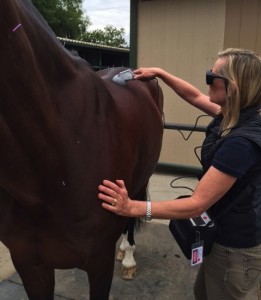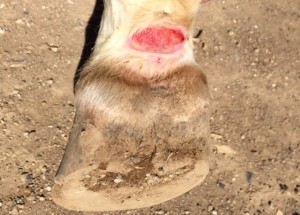Laser Therapy for the Horse
 Chances are you have heard something about laser therapy being done on horses or someones dog or even on a friend! In brief, Low-Level Laser Therapy (LLIT) is a light therapy frequently used to treat musculoskeletal pathologies.
Chances are you have heard something about laser therapy being done on horses or someones dog or even on a friend! In brief, Low-Level Laser Therapy (LLIT) is a light therapy frequently used to treat musculoskeletal pathologies.
What Laser Therapy can do
Laser Therapy can accelerate healing and improve the repair, regeneration and remodeling of tissue in the horse. Some uses for laser therapy are wound healing, pain management, tendon/ligament injuries, muscle tears, neurologic injuries and stimulation of acupuncture points. Some benefits of laser therapy are decreased pain, increased wound healing, decreased inflammation, increased tensile strength of tendon/ligament and a return to function.
Class of Laser
Lasers are classified depending on the power or energy of the beam and the wavelength of the emitted radiation. It is based on the laser’s potential for causing immediate injury to the eye or skin and the potential for causing fires from exposure to the beam or reflections of the beam. The class of laser has nothing to do with the efficacy of the treatment. They range from Class 1 to 4.
Class 1: Considered incapable of producing damaging radiation levels. Example- laser printer.
Class 2: Emit radiation in the visible portion of the spectrum. Hazardous if you look directly at them for a long time. Example- laser pointer.
Class 3a: Usually won’t produce injury if viewed only momentarily with the unaided eye. Example- HeNe laser with 1-5 milliwatts (mW) radiant power.
Class 3b: Can cause severe eye injury if beam viewed directly or specular reflections (off a shiny surface) viewed. Not normally a fire hazard. Example- visible HeNe lasers 5-500 mW.
Class 4: A hazard to the eye from direct, specular and sometimes diffuse reflections. Can start fires and damage skin.
Not to scare you about laser therapy but retinal (eye) injuries can occur instantaneously with Class 3b and Class 4 lasers and the damage may be irreparable. I am telling you this so that you don’t just pick up a laser and start using it on your animal and so that you make sure whoever is treating your animal knows how to use the machine and takes the appropriate precautions.
Therapeutic Laser Therapy
In the equine world most therapeutic laser therapy is with a Class 3b or Class 4 laser. Current scientific and clinical research shows Class 3b lasers are best suited for therapeutic applications and Class 4 lasers are best suited for tissue destruction. Laser light is delivered in wavelengths (nanometers). Laser light is highly absorbed by water (humans and animals are at least 60% water) at wavelengths greater than 950 nanometers (nm). 99% of this energy is absorbed before penetrating the skin, leading to a high risk of thermal damage (burns) and a low depth of penetration.
Class 3b lasers maximum wavelengths are generally below 950 nm. Class 4 lasers generally have wavelengths up to 980 nm. It has not been proven in scientific literature that higher power is better. It is, in fact, the opposite. There is a therapeutic “optical response” window between 600 nm and 950 nm with the maximum effect range from 650 – 930 nm.
The Bottom Line
In other words, just because a laser is more powerful and can be treated faster, does not always make it better. What is extremely important is the knowledge and expertise of the person operating the laser. You want them to have a thorough knowledge of equine anatomy, equine medicine and the operation of the laser. Not every condition can or should be treated with laser therapy and injuries often have secondary complications that you don’t want missed.
Laser therapy is a great tool to add to our treatment and rehabilitation protocol. At Progressive Equine, Dr. Rydgig uses the Respond Luminex Vet Class 3b laser. Talk with your veterinarian to see if Laser Therapy is the right therapy for your horses injury or situation.


